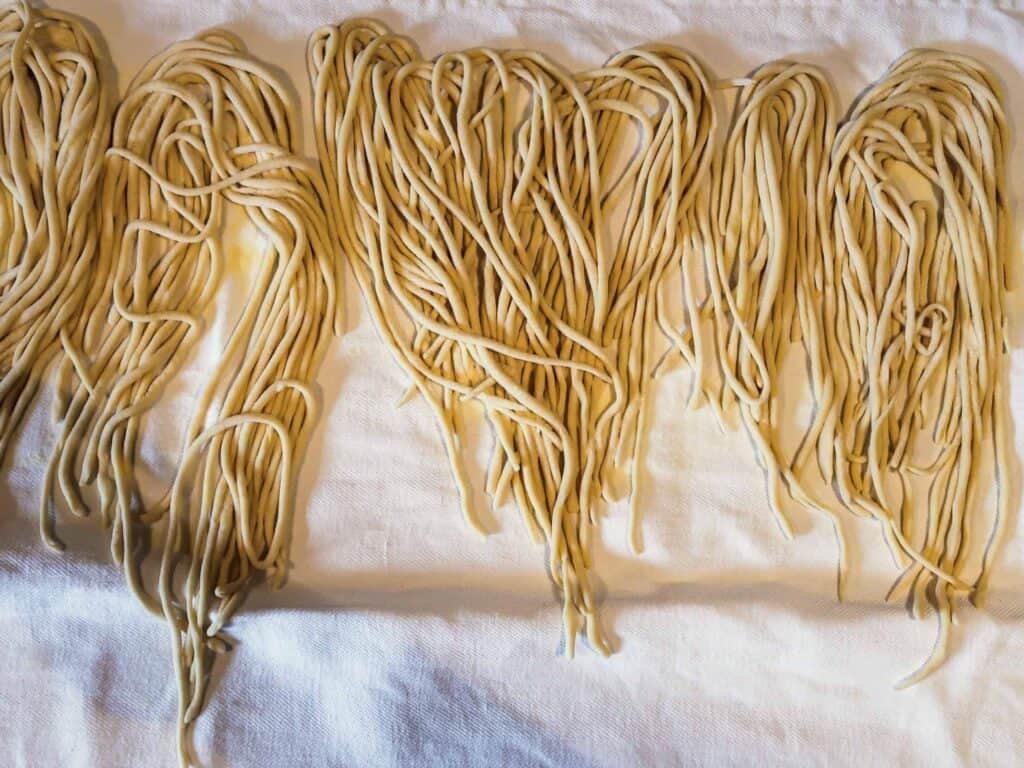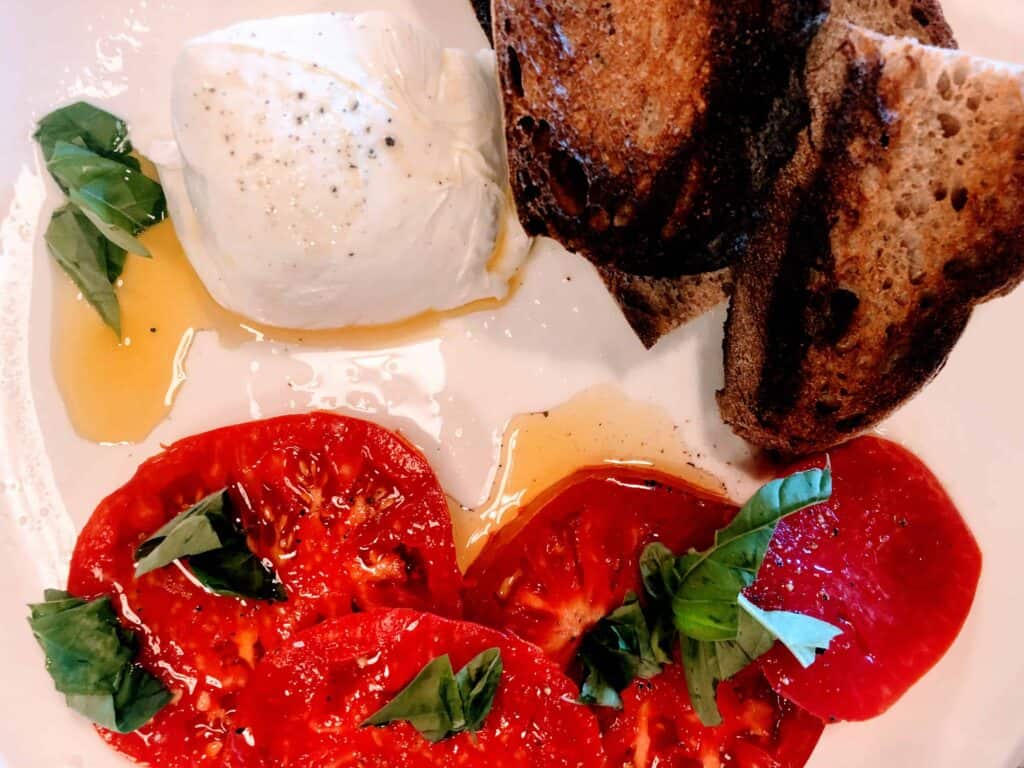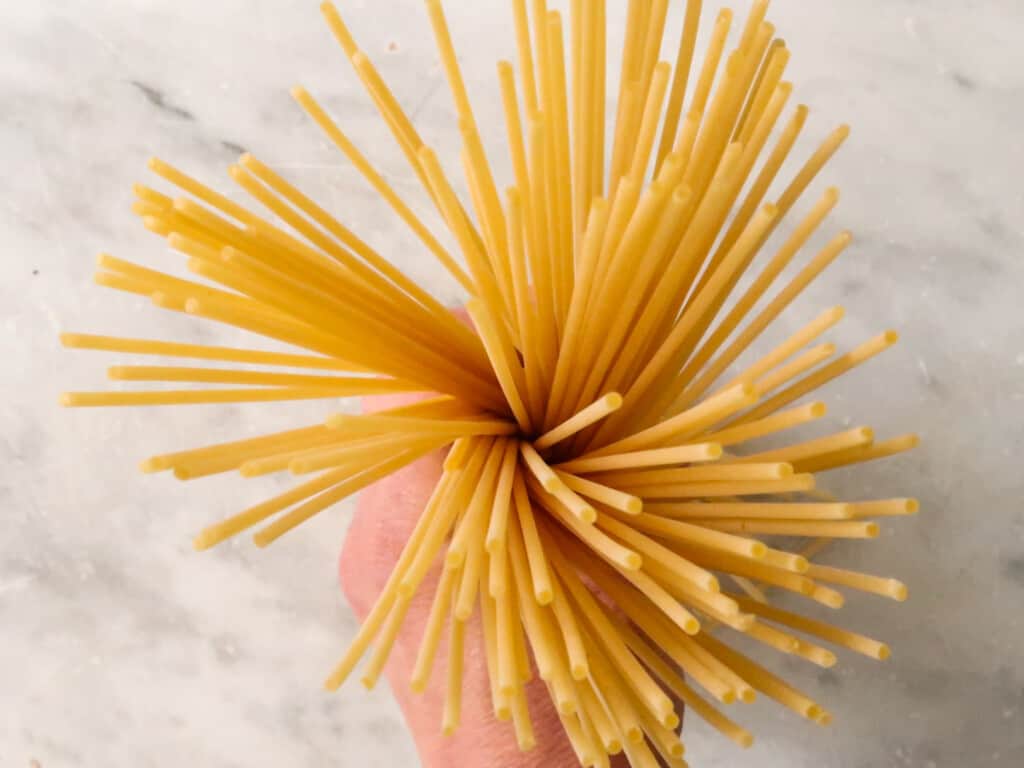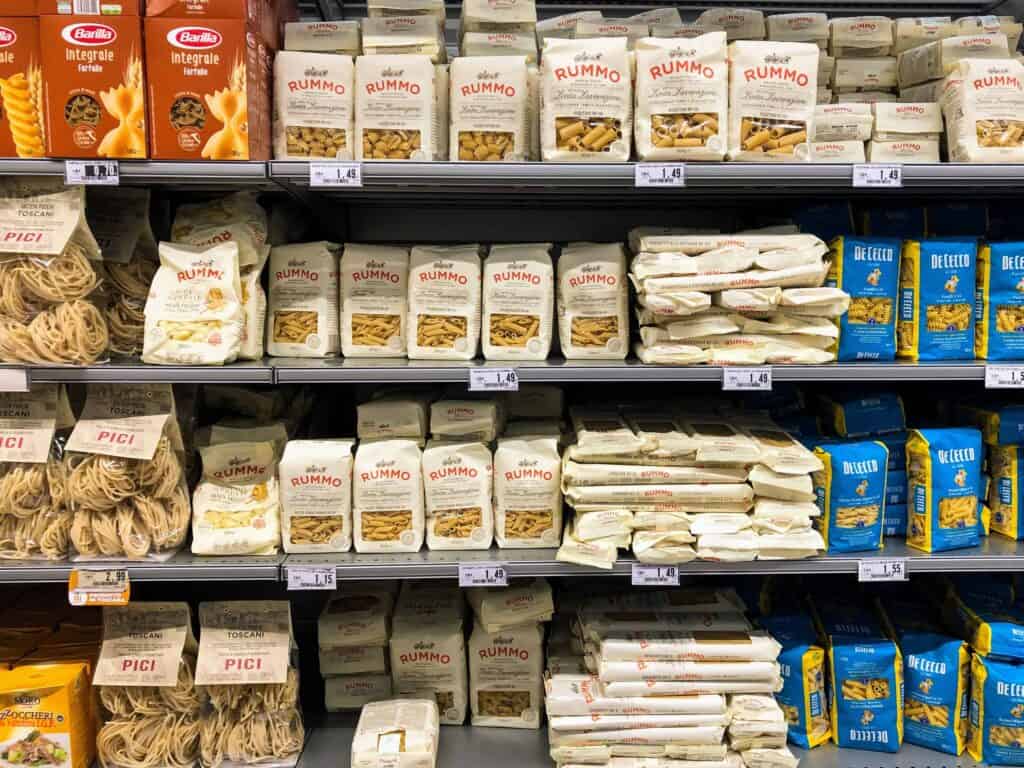Last updated on April 19th, 2024
It’s probably never occurred to you that cooking pasta is an art form. Well, here in Italy it is!
On paper it couldn’t get more basic: just cook salt, water, and pasta.
But after having suffered countless soggy and mushy pasta dishes outside of Italy, it’s my mission to make sure you can cook pasta just like an Italian!
Jump to Section
What is Perfectly Cooked Italian Pasta?

So what exactly does perfectly cooked pasta look and taste like?
Italians refer to perfectly cooked pasta as al dente meaning “to the tooth” in Italian. It describes the ideal consistency of pasta which is not soggy but rather firm on the inside with a bite to it.
Good To Know: The term al dente is also used when cooking rice in Italy and should not be confused with molto al dente which means slightly undercooked pasta (which does have its place in the kitchen!). Learn more Italian Cooking Terms.
You may be worried al dente will be hard to identify but don’t worry! Pasta packaging offers recommended cooking times for making al dente pasta. Don’t miss our guide to the top Italian Pasta Brands to use!
But the real test is by biting or cutting into the pasta just 1-2 minutes less than the package’s recommended cooking time. Look for a small, slightly less ‘hydrated’ inner core of the pasta. Taste it. Is it chewy and springy? If the answer is yes then turn off the burner and get that pasta drained!
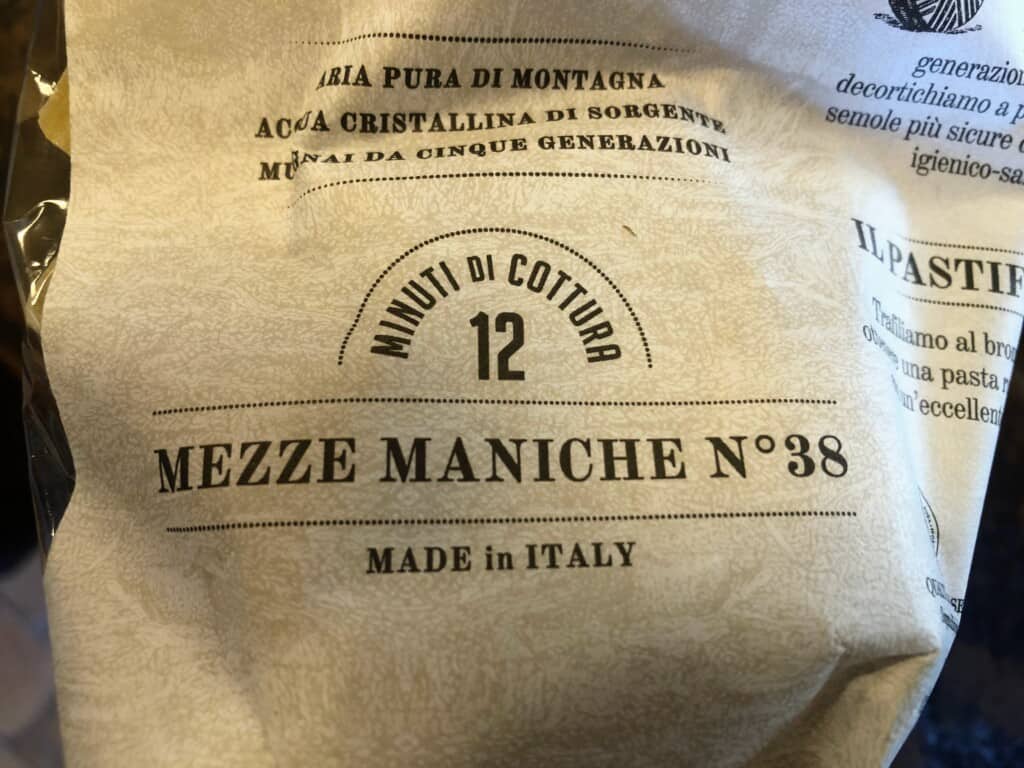
Cooking Italian Pasta – Steps & Tips
Check out our full guide on How To Cook Pasta Like an Italian
- Start with a large pot for cooking 1 lb of pasta, at least a 6-quart pot. Make sure it’s deep if you’re cooking longer shapes. This is key to keep the pasta from sticking together.
- One of the most debatable topics in cooking pasta is whether to start with cold water or hot water. Here in Italy, it’s customary to use cold water because it is said that hot water contains more minerals from your pipes, affecting the flavor of your pasta. Some Italians, however, start with hot water and they claim no one knows the better of it. In our house, we always start with cold water (unless I am really running late and then I will start with extremely hot tap water).
- Bring your pasta water up to a boil, and cover it. It takes less time this way.
- The next step is extremely important and distinguishes good pasta from bad. Salt your water! You will want to use 2 tablespoons of rock salt, as it has a different sodium content than table salt, for every 6 quarts of water. It may seem like a lot but this really is how much salt they use in Italy. The water should taste like the ocean!
- Add your pasta to the boiling water and start your timer.
- Immediately stir the water to keep the pasta from sticking and continue to stir every 2-3 minutes. Keep the water at a rolling boil, uncovered. If that means turning the heat up, go for it.
- Start checking your pasta to see if it’s al dente 1-2 minutes before the minimum recommended cooking time. Test often! Pasta can go from al dente to overcooked in a matter of 30 seconds so keep a close eye on that pot of water.*
- Drain your pasta, return it to the pot, and toss with your chosen sauce. Don’t rinse your pasta!
If you plan to finish cooking your pasta in a hot pan with the sauce (like when you are making carbonara or perhaps a lightly cooked fresh tomato and basil sauce) cook the pasta molto al dente (2-3 minutes before the recommended cooking time), just undercooked as you will finish it in the sauce.
*To tell if it’s done (al dente), use a fork to pull out one piece of pasta, let it cool slightly (10-20 seconds or so), and bite or cut into it. Your pasta should be chewy and have “a bite” to it in the center. Check out our full article here explaining in detail what and how to identify what al dente is.

Insider’s Tip: Do yourself a favor and save about 1 cup of starchy pasta water which you can use later to thin out sauces and help bind the sauce to the pasta if you are finishing the pasta in a hot pan.
Good To Know: The only time you want to cook pasta in broth is when you are serving it directly as a soup, which I highly recommend in the winter – there is nothing more comforting! Tortellini and other pasta dumplings are perfect for soaking up the deep, earthy chicken or beef broth. And don’t forget to serve it with a sprinkle of parmigiano!
How to Cook Dried Pasta – A Summary

Known as pasta secca in Italian, dried pasta is the most common pasta in Italy with over 350 varieties! It’s one of the best items to bring back with you from Italy as it’s very light.
- Fill a very large pot with at least 6 quarts of water for 1 lb of pasta
- Cover and let come to a rolling boil
- Salt water with 2 tablespoons of rock salt for 6 quarts of water
- Add pasta and stir immediately. Keep the water at a rolling boil
- Keep stirring every 2-3 minutes to ensure it doesn’t stick
- Check pasta 1-2 minutes before the indicated cooking time
- Save a cup full of pasta water
- Drain well in a colander. Do not rinse the pasta.
- Toss with your sauce and serve piping hot!
Eat Like An Italian: After all that hard work learning to cook your pasta correctly, learn to eat it like an Italian with our in-depth guide: Is it Illegal to Break Pasta in Italy? + Quick Guide to Italian Pasta Etiquette.
How to Cook Fresh Pasta – A Summary
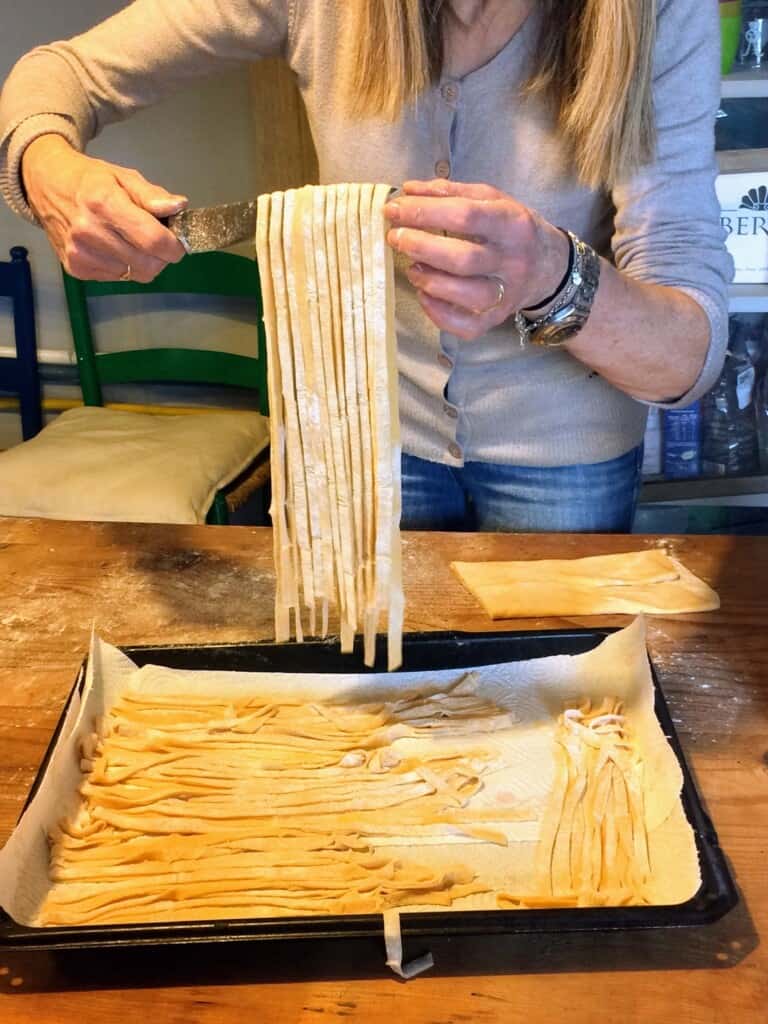
Pasta fresca only takes a few minutes to cook, anywhere from 3-6 minutes, depending on the variety. Because of this, it is trickier to get right than dried pasta so try to master dried pasta before moving on to fresh. Keep a close eye on the pot and the moment you see the pasta float to the top, it’s ready!
- Fill a very large pot with at least 6 quarts of water for 1 lb of pasta
- Cover and let come to a rolling boil
- Salt water with 2 tablespoons of rock salt for 6 quarts of water
- Add pasta and stir immediately. Keep the water at a rolling boil
- Keep stirring every 2-3 minutes to ensure it doesn’t stick
- Check pasta 1 minute before the indicated cooking time but take it out if you see it float to the top.
- Save a cup full of pasta water
- Drain well in a colander. Do not rinse the pasta.
- Toss with your sauce and serve piping hot!
Cooking Pasta – Troubleshooting

- If you have undercooked your pasta, put it in a saute pan with your sauce (except pesto or fresh mozzarella!) and cook over medium heat for an extra minute.
- If you have overcooked your pasta there is not much to do. Rinsing it off with cold water will not save it at this point and will only remove any of the good starch that helps in binding the sauce to the pasta. My only suggestion if you don’t want to eat it as is and don’t want to throw it away is to repurpose it into baked pasta which is typically overcooked anyways. Just add bechamel and grated parmesan cheese and broil it until bubbling. Broiling it, as opposed to baking it for 30 minutes, will get you a golden crust but keep it from cooking even more.
- If your pasta is stuck to the pan, please do not add oil! Often, you will hear people saying you should put a glug of olive oil in the boiling water to keep the pasta from sticking to the pan. This is false and is just a waste of your precious EVOO (extra virgin olive oil)!
- If you have extra pasta, check out these two great ways Italians use extra pasta:
- Frittata – They will beat up some eggs, add the leftover pasta and make a large frittata. This Italian omelet often is a vehicle for additional flavors, such as pasta al ragù.
- Pasta al Forno – Make a simple bechamel sauce, toss with the leftover pasta, cover with grated parmesan cheese and bake at 350 degrees for 30-40 minutes until golden. In our house, we sometimes even make extra pasta to have an excuse to have pasta al forno the next day.
Learn a Trick: Read The Secret Ingredient That Takes Any Pasta Sauce to the Next Level.

Do you enjoy making and eating Italian pasta? If so, check out these recipes:
Orecchiette Pasta Recipe
Pici Pasta Recipe – How To Make Tuscany’s Hand Rolled Spaghetti
Tagliatelle Recipe + How to Pronounce It
Cacio e Pepe Recipe – Pronounce it and Make it Like an Italian (+ Audio)
Fresh Pomodoro Sauce Recipe – An Italian Summer Tradition
Pomodoro Sauce Recipe – Made With Canned Tomatoes
Creamy Kale Pasta Recipe
Italian Kale Pesto Recipe
Aglione Sauce Recipe
Pappardelle alla Boscaiola Recipe
Cooking Pasta FAQs
Italians use a Bimby, similar to an Instant Pot for cooking meals at home, including pasta but it is a secondary tool, a less reliable method. Traditional dried pasta is the most consistent while fresh pasta, gluten free varieties and egg noodles can be tricky. Most Italians cook pasta the traditional way so we suggest you do the same!
Can you freeze cooked pasta? Yes. Do we recommend it? No. There are great ways to repurpose leftover pasta and by freezing it you are eliminating the al dente factor that you have just worked so hard to achieve.
While microwaves are sometimes used for heating up leftover pasta (although most Italians just use a saucepan and a bit of oil), they are never used to actually cook the pasta.
There is nothing you cannot do but the whole point of cooking pasta like an Italian is to achieve the al dente bite that we have talked all about. If you cook it ahead of time you might lose this as the pasta continues to cook as it cools down and then will need to be reheated.
At the end of the day pasta is really one of the easiest dishes to make so why try and get around it with all these ‘tricks’ and ‘tools’ that don’t actually improve your pasta. If you really want to help yourself, make your sauces ahead of time and in big batches so you can preserve or freeze them for easy dinners anytime!
